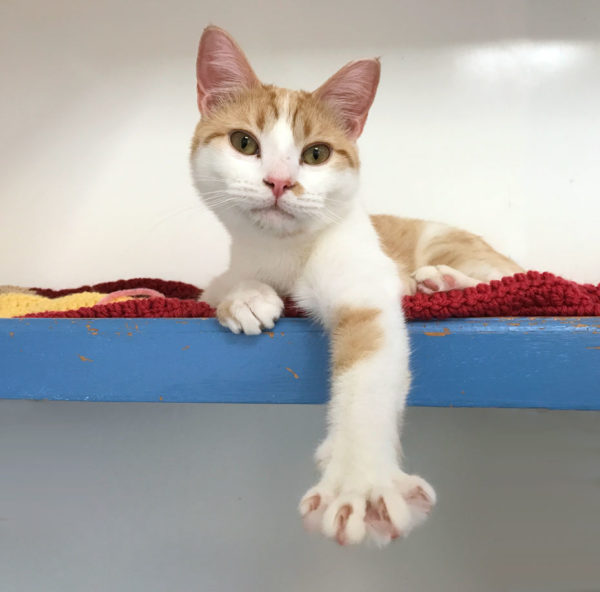Can a kitten be declawed at birth?
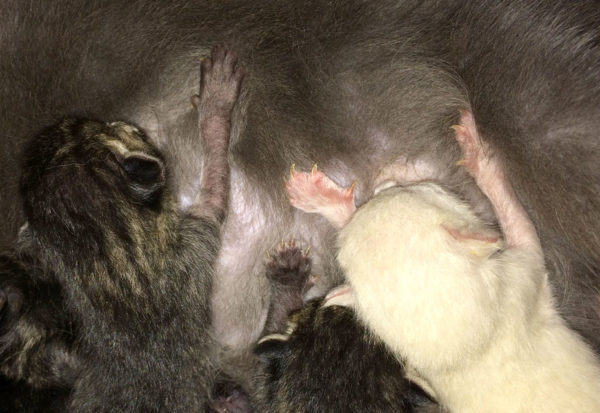
Someone asked this through the Happy Cats Haven website recently. It’s a fact that cats come with claws. Scratching and touching with their claws is a basic cat instinct, like eating or purring. Not only does it keep their bodies functioning properly, but it’s a big part of how they communicate.
HISTORY OF DECLAWING
Many of us have declawed cats when the procedure was developted in the 1970s, as more and more cats became indoor cats. Dr. Marcus Brown, President of the American Association of Feline Practitioners, says “I think many cat owners just had no idea that a declaw is an amputation.” There was virtually no research done to make sure the procedure was safe or humane before it became widespread.
At one point, declawing was part of a veterinarian’s “kitten package”, touted as if necessary to regular veterinary care. Even many professionals didn’t know better. The side effects, complications and aftercare of the procedure weren’t taught in vet schools, according to Dr. Jean Hofve, the Colorado veterinarian who authors the website Little Big Cat.
Most people now realize that declawing can have lasting effects on a cat, many of which are worse than the behavior it is trying to prevent. It’s estimated that over 80% have at least one complication and over 30% will end up with behavioral problems (Becker Jan 2014). Along with being more likely to have litterbox, biting, aggression and overgrooming issues, declawed cats are 3 times more likely to have back pain from the procedure negatively impacting their ability to move properly (Martell-Moran May 2017).
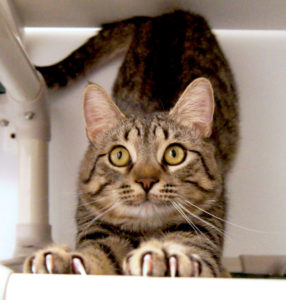
Many veterinarians and veterinary technicians will admit the procedure is “gut-wrenching.” (Becker Jan 2014). Declawing is no longer taught in some veterinary schools, is now an elective in most. It was recently opposed by the Canadian Veterinary Medical Association and is banned completely in Europe, as well as eight California cities and now, Denver. The CMVA has labeled the procedure “unethical.”
Some veterinarians argue that declawing should be an option because otherwise the guardian will be more likely to give the cat to a shelter. In fact, The Paw Project found that after declawing bans went into effect in Los Angeles, there was a 43% reduction in the number of cats who were surrendered.
CAT CLAWS & DOG CLAWS
Dr. Hofve points out that no one would think of declawing a dog, even though dog claws can also do considerable damage to furniture, floors and skin. One veterinary school professor reasoned that a dog will continue to cry out in pain whereas a cat is more stoic. This causes even more pain in cats than debarking or tail docking in dogs, which professional veterinary associations oppose because they are clearly inhumane.
Cats are solo hunters who mask any behavior that could make them more obvious to a predator. Their ability to mask pain is why it may seem like the procedure has had little effect on a cat at first.
APPROPRIATE SCRATCHING
Just because your cat needs to scratch doesn’t mean he needs to scratch on your furniture. There are lots of ways to make sure his needs are met while keeping your furniture intact.
Cats have scent glands in their paw pads that let them leave pheromones on the scratcher. This is like email for cats. The message is left for other cats to “read,” allowing them to communicate without getting into each other’s personal space. Most cats will do what they can to avoid fights and this helps them do that.
Another use of their claws is kneading, sometimes known as “making biscuits.” A grown cat may snuggle up to you and start rhythmically extending and withdrawing his claws into your clothing.
This is one of the biggest compliments a cat can pay you, since he is reacting to you as if you were his mom. Kittens knead into their mother’s stomachs as they nurse, purring happily. Simply adding another fabric layer under your cat to give him a nice soft surface instead of your leg on which to knead will keep both you both happy.
CAT SCRATCHERS
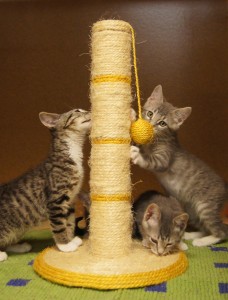
A cat tree or scratcher is part of the basic equipment you need to have a happy, normal cat. The trick to making sure your cat uses his scratcher instead of the furniture is to make the scratcher more valuable to your cat than your furniture is.
Most cats have very specific preferences for the kind of scratcher they like. Some like to scratch vertically while some prefer horizontal scratchers. Some prefer cardboard while others like rope or carpet.
You can start by finding out what type of scratcher your cat prefers. At Happy Cats Haven, we offer different types of scratchers to our cats to try to figure that out for their new families.
FINDING THE RIGHT SCRATCHER
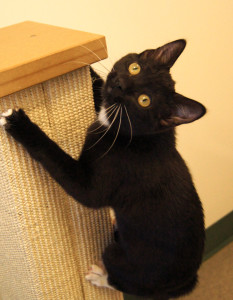
If you don’t know what your new cat likes, let him tell you by offering a couple of orientations and surfaces. You can purchase a small vertical scratcher fairly cheaply ($20 at Happy Cats Haven), in different surfaces such as carpet or sisal. The smallest ones are good only for kittens or very small cats, but if your cat is drawn to scratching upright, you’ll know to invest in a larger, more stable scratcher.
Drag your cat’s favorite cat toy over the cardboard to lure him onto it. When he grabs for the toy, he should show you whether he likes the feel of the cardboard by scratching or not. You can also entice some cats to scratch by sprinkling the surface with their favorite catnip.
If he doesn’t want to scratch upright, simply tip the scratcher over and entice him with play or catnip. There are many types of horizontal scratchers in sisal, cardboard and carpet versions.
It’s always helpful to tell your cat or kitten when he does something right. We all do better with smiles than frowns! After your cat finishes scratching, tell him “Good boy!” and give him a small treat to reinforce him doing what you want.
A word of warning: if you have an adult cat, make sure your vertical scratcher is at least 20 inches high and avoid scratchers that don’t have a heavy enough base to keep from tipping over. Many commercial scratchers are really only good for kittens; if you look closely at their photos, you’ll see an absence of adult cats. If the post tips over on your cat while he’s scratching, it can make him afraid of scratching in the right place.
If your cat doesn’t scratch either way, he probably prefers a different surface. Note which surfaces you’ve tried and try a different one. We’ve never met a cat who didn’t like to scratch on either carpet, sisal, rope or wood.
Because you are a part of your cat’s colony, you can make the scratcher even more valuable by leaving your own scent on it. Simply rub the scratcher occasionally as you go by. This will reinforce the scratcher as an acceptable place for your cat to leave his or her scent by scratching.
Once you see which surface the cat prefers, you can set up more scratchers in the house. One scratcher per cat is usually adequate, but having additional ones increases the odds your cat will use them rather than the furniture.
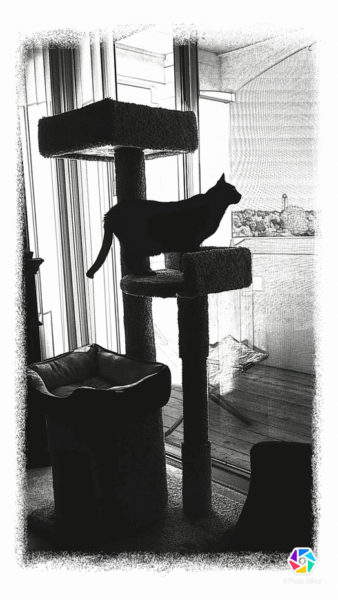
A high cat tree has the advantage of providing additional territory for one or more cats. Plus, it’s a natural behavior for cats to be high and safe where they can observe everything, especially to look out windows. This can be very valuable if you have other residents the cat may want to get away from occasionally, like small children or dogs.
SCRATCHER PLACEMENT
Placement is also very important to your cat. Most cats prefer their scratchers to be in areas where they and their people are active. If you put the scratcher off in a corner somewhere you never go, there will be no reason for them to use it.
Placing a scratcher in front of the corner of a couch is often a good way to help them mark appropriately. Happy Cats carries scratchers that are offset so they can be placed right at the corner of a couch. Putting a scratcher in the same area as a litter box is a good idea too, since one will reinforce the other in the cat’s communication system.
Dr. Steve Dale, the Chicago veterinarian and feline behaviorist, also suggests placing a scratcher near where your cat likes to nap, as stretching and scratching when waking up often go together. Since many cats like to scratch when their people come home as a sign of being happy to see them, placing a scratcher near your front door is a good option too.
SCRATCHING BARRIERS
If your cat is still drawn to an area where you don’t want him to scratch, you can make that place less pleasant for him. Many cats dislike double-stick tape, which comes in wide rolls for applying to furniture. You can also use aluminum foil and the back side of vinyl carpet runners (spiky side up) to discourage scratching.
As a last resort, Jackson Galaxy also recommends a product called SSSCat, a motion-activated compressed air device. This can act like a huge hissing monster to your cat and possibly scare him away from his scratching place. However, punishment always has fallout, so your cat might be permanently scared away from the room your furniture is in, unwilling to come sit on your lap on the couch, for example. It’s always good to look at the whole picture and try to think like your cat.
DIY SCRATCHERS
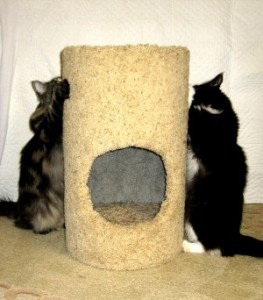 A cat tree can be an investment, but compared to the cost of new furniture or a declawing (which has huge longterm costs to your cat), it will be money well spent.
A cat tree can be an investment, but compared to the cost of new furniture or a declawing (which has huge longterm costs to your cat), it will be money well spent.
Scratchers can be inexpensive to make. You can use scrap carpet or sisal rope and a staple gun to cover your own post. Just make sure the staples are securely embedded in the surface and make sure the bottom is heavy enough not to tip over.
This scratcher was made from a heavy fiberboard cylinder made to form concrete called a Sonotube. We cast concrete in the bottom, cut out the side hole and used a piece of plywood for the top, then covered it all with carpet scraps, total cost less than $20.00. You can contact Happy Cats for more information on how to do it yourself.
TRIMMING CLAWS
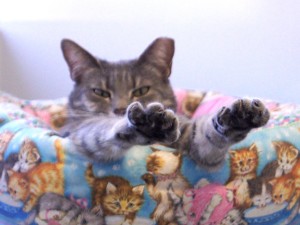
Any cat can be taught to tolerate or even enjoy nail clipping, to help them avoid getting caught on the carpet or furniture and to reduce the risk during play. You may only need to trim the front claws. If done correctly, claw clipping should never cause pain, which is the biggest factor in cats not accepting clipping.
If started in kittenhood, nail trimming can actually be just as pleasant an experience as petting and cuddling, for most cats. Start by gently and regularly handling the legs and paws. Give your cat a treat when he relaxes and accepts the handling. Over several days if necessary, work your way up to being able to squeeze the paw to expose the nail for a few seconds, treating at the end of the squeeze.
Once you’ve gained that level of trust with your cat, find a clipper that you are comfortable handling. We recommend the blunt scissors-type clippers that can be found everywhere from dollar stores to pet supply stores. Plan your session when your cat is already relaxed and sleepy, like when he is napping in the sun.
Start by clipping a single nail and then immediately follow with a treat and a “Good kitty!” As Dr. Becker says, you can start with “a nail a day.” Just clip the tips so as not to risk hurting your cat, because pain will immediately teach him to hate claw clipping.
If you teach your cat that nail clipping never hurts and always gets a reward, it will become just another fun thing you can do with your cat. If you have learned clicker training, the process will go even more quickly and pleasantly. Claw clipping is one of the things we teach in our Kitty Kindergarten classes for kittens and Eat Play Love class for adults. This girl learned how to trim her kitten’s nails in our Kitty Kindergarten class.
If your cat is older, the same principles still apply: break the method down into small steps, clip when the cat is already relaxed, go slowly and reward for every step, and always avoid hurting your cat with a misplaced clip.
Even if your cat has been hurt by nail trimming in the past, it’s not impossible to retrain him to tolerate nail clipping. You’ll have to use a different tool and clicker training to rewire their fear response, but it can be done. Please call us at Happy Cats for a referral to a cat behavior specialist who can help with that.
CLAW CAPS
If you wish to use claw caps on your cat, consider using them as a temporary training tool. They will make scratching unpleasant but can disrupt the cat’s natural stretching and communication abilities. However, they can make your furniture temporarily unappealing, which you can use to your advantage.
When the caps are about to wear off, introduce a sturdy new scratcher with a surface your cat likes, in a place the cat will use it. Your cat will then be able to transition to the new scratcher and likely forget about the furniture. This method helps you avoid the expense and trauma of constant claw caps. Then you can put that time and energy into reinforcing for good behavior, making it much more fun for both you and your cat.
DECLAWING REALITY CHECK
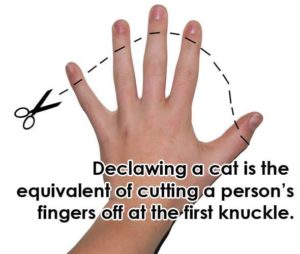 Declawing is not just removing a cat’s nails, sometimes euphemistically referred to as a “nail job.” It’s actually an amputation, where the tip of the toe is cut off, along with the tendon that attaches it. If you have any question that this might be a painful procedure, just think about how that would feel if it were all 10 of your fingertips.
Declawing is not just removing a cat’s nails, sometimes euphemistically referred to as a “nail job.” It’s actually an amputation, where the tip of the toe is cut off, along with the tendon that attaches it. If you have any question that this might be a painful procedure, just think about how that would feel if it were all 10 of your fingertips.
While some cats appear to have normal behavior after being declawed, many others never recover emotionally. We often see a constant low level of anxiety or crankiness with cats who have been declawed. They also have a tendency to resort to biting to communicate as their claw communication system has been disrupted.
Research proves that declawing can directly lead to litter box issues as well. When cats come home after the procedure, their paws are bandaged tightly to keep from bleeding. The first thing they may need to do is use the litter box. Before the declawing, scraping and covering in the box was satisfying, but now it is likely painful. This can put a cat off from using his box if he associates pain with it.
According to Dr. Karen Becker of the website Healthy Pets, it is common for an outgoing, social cat to become a hider, spending most of his time out of reach of those who once were his human friends, probably because he is in pain, just like he would be if he were wounded.
A cat may also become more of a biter, as that’s another form of communicating and may be what he resorts to when his normal means of communication is taken away.
Unlike human nails, a cat’s claw grows out of the bone, necessitating a total amputation of the last bone in the toe. This also severs the tendon and nerves. Declawing changes everything about the way a cat walks, not just how he scratches. Is it not uncommon for a cat to lose a limb because the bandages were applied too tightly. A declawed cat is 3 times more likely to have back pain because cats walk on their toes and removing them negatively impacts their whole ability to move.
Declawing is known to cause so much pain that it’s the procedure used to test new pain medications in cats. Research shows that, even with pain medication, cats are still in pain nearly two weeks after the procedure. It also affects the elbow and the spine, often leading to arthritis down the road.
There are millions of indoor cats in the world who prove that cats can scratch appropriately. Happy Cats Haven does not recommend or support declawing and is grateful to work with veterinarians who also do not or who use it only when all training avenues have been completely exhausted.
Fortunately, Colorado Springs has two excellent feline behavior consultants who can help with training a cat or kitten to use approved surfaces in the home. Please call Melissa Shandley at 719-686-8773 or Carole Galloway at 719-495-1858 to set up an appointment.
Your furniture will age in many other ways besides being scratched by your cat. If you have any doubts that declawing might be harmful for your cat, just imagine how it would feel if all 10 of your fingertips were chopped off, removed by the very people you love and trust the most. Is a couch or chair really worth more than the complete trust your cat gives you to care for him or her?
